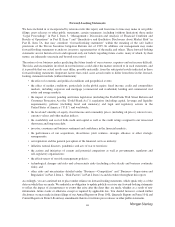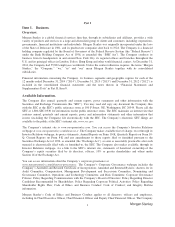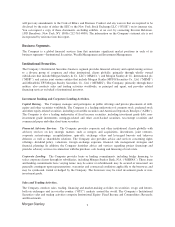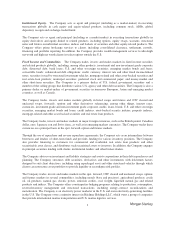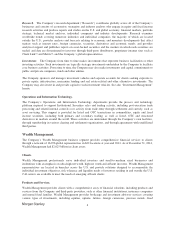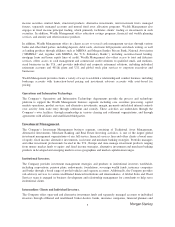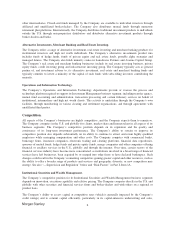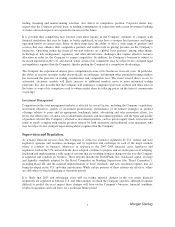Morgan Stanley 2014 Annual Report Download - page 14
Download and view the complete annual report
Please find page 14 of the 2014 Morgan Stanley annual report below. You can navigate through the pages in the report by either clicking on the pages listed below, or by using the keyword search tool below to find specific information within the annual report.
capital requirements and advanced measurement approaches for determining operational risk capital
requirements to calculate and publicly disclose their risk-based capital ratios beginning with the second quarter
of 2014, subject to the “capital floor” discussed below (the “Advanced Approach”). As an Advanced Approach
banking organization, the Company is required to compute risk-based capital ratios using both (i) standardized
approaches for calculating credit risk weighted assets (“RWAs”) and market risk RWAs (the “Standardized
Approach”); and (ii) an advanced internal ratings-based approach for calculating credit risk RWAs, an advanced
measurement approach for calculating operational risk RWAs, and an advanced approach for calculating market
risk RWAs under U.S. Basel III.
To implement a provision of the Dodd-Frank Act, U.S. Basel III subjects Advanced Approach banking
organizations that have been approved by their regulators to exit the parallel run, such as the Company, to a
permanent “capital floor.” In 2014, as a result of the capital floor, an Advanced Approach banking organization’s
binding risk-based capital ratios were the lower of its ratios computed under the Advanced Approach and U.S.
Basel I as supplemented by Basel 2.5. Beginning on January 1, 2015, the Company’s ratios for regulatory
purposes are the lower of the capital ratios computed under the Advanced Approach or the Standardized
Approach under U.S. Basel III. The U.S. Basel III Standardized Approach modifies certain U.S. Basel I-based
methods for calculating RWAs and prescribes new standardized risk weights for certain types of assets and
exposures. The capital floor applies to the calculation of the minimum risk-based capital requirements as well as
the capital conservation buffer and, if deployed by banking regulators, the countercyclical capital buffer. The
methods for calculating each of the Company’s risk-based capital ratios will change through January 1, 2022 as
U.S. Basel III’s revisions to the numerator and denominator are phased in and as the Company calculates RWAs
using the Advanced Approach and the Standardized Approach. These ongoing methodological changes may
result in differences in the Company’s reported capital ratios from one reporting period to the next that are
independent of changes to the Company’s capital base, asset composition, off-balance sheet exposures or risk
profile.
U.S. Basel III also requires the Company and its U.S. Subsidiary Banks to comply with supplementary leverage
ratio requirements, which U.S. banking regulators increased in 2014 above standards established by the Basel
Committee. Specifically, beginning in 2018, the Company must maintain a Tier 1 supplementary leverage capital
buffer of greater than 2% in addition to the 3% minimum supplementary leverage ratio (for a total of greater than
5%), in order to avoid limitations on capital distributions, including dividends and stock repurchases, and
discretionary bonus payments to executive officers. In addition, beginning in 2018, to be considered “well-
capitalized” the Company’s U.S. Subsidiary Banks must maintain a supplementary leverage ratio of 6%. The
denominator of the supplementary leverage ratio, as revised by the U.S. banking agencies in 2014 to conform
with revised leverage standards adopted by the Basel Committee, is based on the average daily balance of
consolidated on-balance sheet assets under generally accepted accounting principles in the U.S. (“U.S. GAAP”)
less certain amounts deducted from Tier 1 capital at quarter-end and the average month-end balance of certain
off-balance sheet exposures associated with derivatives (including centrally cleared derivatives and sold credit
protection), repo-style transactions and other off-balance sheet items during the calendar quarter. The enhanced
supplementary leverage ratio standards will become effective for both the Company and its U.S. Subsidiary
Banks on January 1, 2018 with quarterly public disclosure beginning on January 1, 2015.
Although U.S. Basel III is in effect, the U.S. banking agencies and the Basel Committee have each proposed, or
are considering proposing, revisions to the regulatory capital framework that would modify the regulatory capital
standards governing the Company and its U.S. Subsidiary Banks. In December 2014, the Federal Reserve issued
a proposed rule that would impose risk-based capital surcharges on U.S. bank holding companies that are
identified as global systemically important banks (“G-SIBs”). Although the Federal Reserve’s proposal is based
upon the Basel Committee’s international G-SIB surcharge framework, the methodologies proposed by the
Federal Reserve generally would result in G-SIB surcharges that are higher than the levels required by the Basel
Committee framework and would directly take into account the extent of each U.S. G-SIB’s reliance on short-
term wholesale funding. Under the proposal, a bank holding company identified as a G-SIB would calculate its
G-SIB surcharge under two methods. The first would consider the G-SIB’s size, interconnectedness, cross-
10


